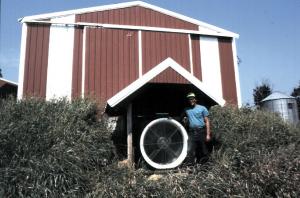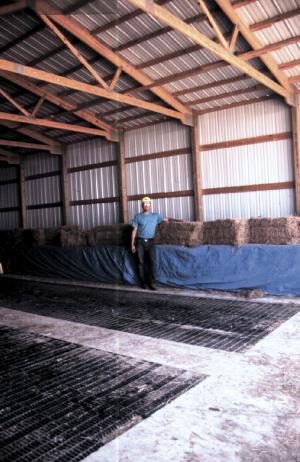2000 - Volume #24, Issue #2, Page #11
[ Sample Stories From This Issue | List of All Stories In This Issue | Print this story
| Read this issue]
Big Square Dryer
 |
 |
Dan Kamps' 30 by 60-ft. building has a concrete floor with inset metal grates. Two 50-ft. long, 7-ft. wide tunnels beneath the floor bring in warm air. As many as 38 3 by 8-ft. bales can be dried at a time.
A 38-in. dia. fan powered by a 15 hp electric motor is housed inside a lean-to alongside the shed, along with a liquid propane gas burner. The fan blows hot air into the two tunnels.
He also dries bales in a second shed equipped with a single 66-ft. long drying floor. It can dry 25 bales at a time.
"It lets me bale at 35 percent moisture and dry them down to about 20 percent moisture, which increases my production and also increases hay quality," says Kamps. "The wet hay stays nice and green and still has all the leaves attached to the stems. I sell the hay at a premium to local horse and goat owners as well as dairy operators.
"I built the hay drying setup about six years ago. At first I used it to dry small square bales but then I switched to big square bales to reduce the labor."
Kamps places the bales in a single layer across each of the grates. The 8-ft. bales cover the entire width of the grates, which keeps air from leaking out. The tunnels under the grates are 3 ft. deep so he can crawl inside them to sweep out leaves.
He used steel slats from a hog confinement building to make the grates. He added extra steel grating on top to provide enough support for his tractor. He salvaged the LP burner from an old grain bin and modified it so that it doesn't run quite as hot. The burner raises the air temperature inside the tunnels 20 to 30 degrees and is controlled by thermostats at either end of the drying floor.
"It costs about $20 per ton to dry the bales which, considering that I get a premium for my high quality hay, is worth it," says Kamps. "The main disadvantage is that drying hay is a slow process. It takes 2 1/2 to 3 days to dry one batch of hay whereas on a good day in the field I can make 70 bales in just one hour."
Contact: FARM SHOW Followup, Dan Kamps, 12058 Pleasant View Road, Darlington, Wis. 53530 (ph 608 762-5882).

Click here to download page story appeared in.

Click here to read entire issue
To read the rest of this story, download this issue below or click here to register with your account number.




